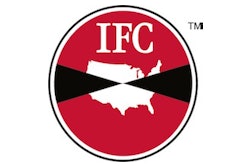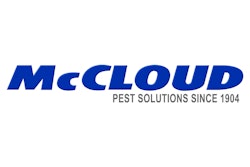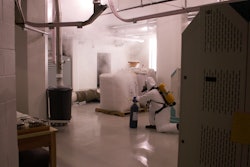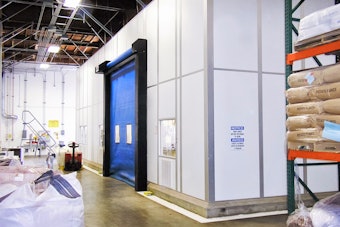
Given consumer demands for high-quality products and stringent food safety regulations, today’s food and beverage manufacturers are more vigilant than ever about preventing pests from contaminating their products. Gone are the days of processors spraying pesticides and fumigants every few weeks and placing traps throughout the plant. Instead, they are developing and implementing integrated pest management (IPM) programs that take a proactive, comprehensive and preventive approach to keep pest infestations at bay.
According to pest management experts, IPM programs have proven to be successful because they treat pest control as an ongoing preventive process rather than reacting to pest problems as single isolated incidents. To create a customized, strategic IPM plan, pest technicians work with processors to regularly assess each plant’s unique needs and site-specific pest risks. With that information, they can develop an IPM program that uses a variety of tools to address the underlying causes of those risks for pest infestation, thereby drastically reducing or eliminating pest problems in a sustainable, long-term way.
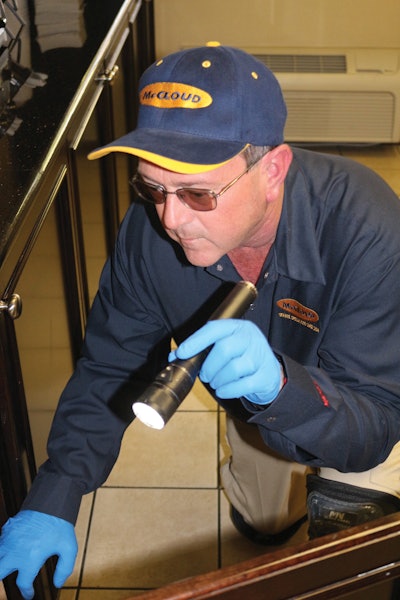 Pest management technicians commonly inspect food and beverage manufacturing facilities at least once a week. Regular inspections are a bedrock of a successful IPM program.Photo courtesy of McCloud Services.
Pest management technicians commonly inspect food and beverage manufacturing facilities at least once a week. Regular inspections are a bedrock of a successful IPM program.Photo courtesy of McCloud Services.
“One of the phrases that you may hear is the ‘spray and pray,’” says Chelle Hartzer, manager of technical services at Atlanta-based Orkin. In other words, plants would just put down some pesticides, and that was it. “IPM has let us look at the root causes of these problems and why are we having them. And how do we solve the initial pest problems where they started instead of just putting a Band-Aid on them? IPM is using all the tools and really trying to prevent issues or prevent issues from getting bigger and getting out of control.”
“Ultimately to solve a pest problem, you need to get to the root cause,” according to Pat Hottel, BCE, technical director at South Elgin, Ill.-based McCloud Services. “You can address the immediate infestation and take care of the current problems, but if you don’t get to the root cause of why it happened, you risk seeing the problem occur again. When IPM is done properly, it can help you get to the root cause.”
Inspection guide
Regular inspection of a facility is a key component of a successful IPM program. Pest technicians and processors typically conduct weekly inspections, but some larger facilities may require daily inspections. During these routine inspections, pest technicians and processors examine and evaluate parts of the plant where pest threats are likely to crop up—areas where pests can access food, water, and shelter. Those vulnerable areas include employee welfare rooms, sections of the processing line where spillage typically occurs, roofs, drains, storage areas, and entry and exit points. These inspections allow the pest technician and processor to locate and correct the conditions in the plant that are conducive to pests. For example, if they find stored product beetles in a certain part of the plant, that may indicate moisture and mold. The processor can then correct the issue that is causing the moisture and mold to develop, helping to prevent future infestations.
These inspections are also crucial to helping the pest technician identify the specific pests that are a threat to that facility—the foundation of any IPM protocol. By correctly identifying the species of pest, the pest control technician has insight into the biology and behavior of that specific pest. That information helps the technician develop targeted treatments and controls that can best prevent that pest from invading the facility.
Cleaning and maintenance checklist
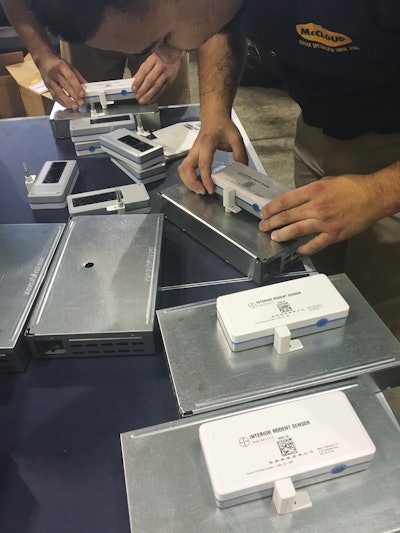 Remote monitoring devices, which are currently only available for rodent traps and bait stations, are new and innovative monitoring tools that send a text or email to the pest technician when a mouse or rat triggers a trap or a bait station.Photo courtesy of McCloud Services.
Remote monitoring devices, which are currently only available for rodent traps and bait stations, are new and innovative monitoring tools that send a text or email to the pest technician when a mouse or rat triggers a trap or a bait station.Photo courtesy of McCloud Services.
“All living things need food, water, and shelter,” Hartzer says. “If we can look at sanitation as limiting what pests have available to them, it can help to reduce those populations. It can help extract them out, which makes it much easier to deal with them.”
In addition, equipment and plant design are essential to effective sanitation. The plant should incorporate design features that prevent dirt, debris, food, or water from building up and attracting pests. For example, sloping drains eliminate ponding water and cove bases without seams or joints don’t allow bacteria, food, or dirt to become trapped. Equipment should also be easily accessible for workers to clean. Pest management experts recommend placing pieces of equipment away from walls and elevating them off the floor to give workers enough space to access and clean them easily.
However, many legacy plants weren’t designed with sanitation in mind. In that case, manufacturers and their pest technicians need to monitor those areas much more frequently to prevent pest infestations. “Accessibility is key to sanitation. And that’s challenging because we can’t do much about the fact that [manufacturers] didn’t think about sanitary design when they built that 20-year-old plant or when they brought in that piece of equipment 10 years ago,” Hartzer says. To compensate for that, those [risk] points must be identified. “Knowing that we can’t really access and clean this piece of equipment very well, [we need to] to monitor it,” Hartzer states. Processing plants must be aware of higher risk areas for pests to develop where equipment sanitation is not feasible. Inspecting all of those things, knowing which pieces of equipment can be easily cleaned on a regular basis versus those that may only get broken down once a quarter or maybe even once a year is key, according to Hartzer. “If we know where those are, we can keep a higher sight line on those areas to prevent those pests from getting out of control and spreading to other areas,” she adds.
IPM programs also tout exclusionary methods as an effective preventive pest control tactic. That means facility maintenance is another important pillar in an IPM program. Maintenance staff must regularly inspect and evaluate the structure of the plant and repair areas that could serve as entry points for pests and harborage points for food, water, dirt, and bacteria. For example, staff should ensure seals or gaskets around doors are intact, seal up the space around pipes, and use steel mesh screens on air handling systems on the roof—areas where pests like rodents can make their way into plants. In addition, the maintenance staff in older plants must stay on top of deterioration problems that plague legacy facilities. For example, the wear and tear on floors can lead to cracks and crevices where debris can build up and attract pests.
“Here in Wisconsin, we still have a lot of old legacy facilities, and they have tile floors that tend to lose the grout at a pretty quick rate,” says Shane McCoy, director of quality and technical training at Wil-Kil Pest Control, based in Menomonee Falls, Wis. “The grout has to be maintained and has to be replaced. They have to regrout their tile periodically. When you have a very small gap or gaps in the entire grout, food and moisture can get trapped in there, and that can be conducive to pests, especially small flies.”
In addition to exclusionary tactics, many manufacturers still use tried-and-true traps to control the pest population in their facilities. They include catch-all traps for rodents; insect light traps for flies and other insects; sticky boards for roaches, flies, and other insects; and pheromone traps for stored product pests.
Breaking the cycle
Sometimes exclusionary pest control tactics and traps just aren’t enough to effectively rid a plant of pests. That’s when manufacturers will also turn to chemical treatments like pesticides. Insect growth regulators (IGR) are particularly popular with food and beverage manufacturers because they disrupt the life cycle of various insects, including roaches, flies, and stored product pests, without exposing the environment to highly toxic chemicals. IGRs don’t immediately kill pests. They mimic juvenile hormones that prevent insects from fully maturing into adults, reducing their life span. IGRs interfere with the insect’s natural hormones, which signal when it should molt into its larval or nymphal stage and then into a reproductive adult. If they do reach adulthood after being exposed to IGRs, those pests are usually sterile and develop deformed features, such as crinkling of a wing.
“Insect growth regulators have come on very, very strong,” states Jerry Heath, product manager and staff entomologist for Lenexa, Kan.-based Industrial Fumigant Company. “It’s very, very low in toxicity and nonhazardous. They have long residual performance and can be applied with aerosol treatments that don’t require the kind of preparation and downtime that fumigation requires.”
The Environmental Protection Agency defines a pesticide as anything that claims to kill, control, repel, or mitigate a population, Hartzer says. “While insect growth regulators don’t kill the insect, it messes up the way they develop, and the insect will actually just die because it can’t develop, but we are still controlling the population, therefore it is still a pesticide,” she says. “That is a great tool to use because it’s so specific to insects. It’s not going to harm a bird or a person or anything like that as long as it’s used properly.”
Under observation
Monitoring is also an integral component of a successful IPM program that focuses on prevention and sustainability. Manufacturers and their pest technicians will use various monitoring tools and techniques to help them gather and analyze pest activity data to determine trends and hotspots for early intervention. For example, they will commonly use pheromone traps and insect light traps to not only trap and kill pests, but to evaluate signs and symptoms of pest activity. Pest technicians will check these traps during their regular inspections of the facilities to figure out the source of pest activity and why those areas are vulnerable.
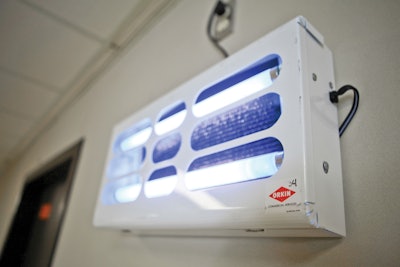 An insect light trap serves as a monitoring device, emitting ultraviolet light to lure and trap flying insects.Photo courtesy of Orkin.
An insect light trap serves as a monitoring device, emitting ultraviolet light to lure and trap flying insects.Photo courtesy of Orkin.
“Deploying remote monitoring technology in a food manufacturing or distribution facility adds another preventive measure in the fight against rodents,” McCoy says.
In addition to traps, visual inspection is important to a monitoring program. It depends on employees to report signs of pest activity in their companies’ pest sighting logs. According to pest management experts, training rank-and-file employees on how to recognize and report pest activity is crucial for the success of the overall IPM program. Many pest management experts recommend training employees on pest control once they are hired. They should also receive ongoing training, such as refresher training annually, as well as when major changes to the production line have occurred and when high employee turnover has taken place. To reinforce that training throughout the year, some manufacturers will include pest control updates during weekly staff meetings and publicize pest management tips and updates on posters and monitors in employee lunch rooms and restrooms.
With data generated from traps and visual inspections from employees, pest technicians will often use propriety software to analyze the data for trends, specific pests, or other vulnerabilities that could affect future pest activity in the facility.
That strategic, preventive approach to pest control has already reaped rewards for Glanbia Performance Nutrition, which has implemented IPM programs at its two plants in Aurora, Ill., with the help of McCloud Services. The maker of nutritional and dietary supplements credits its IPM program for helping it to focus its pest control efforts where it is needed and prevent pest activity. As a result, Glanbia Performance Nutrition has reduced the number of traps it uses by 20% and decreased the amount of pest control chemicals by 75%.
“Our program is based on being proactive instead of being reactive,” says Peter Poteres, global vice president of quality assurance at Glanbia Performance Nutrition. “We work closely with McCloud Services on developing a detailed plan that minimizes equipment (traps, treatments, and bait stations), but maximizes protection. It frees up our technician to do more inspection, be proactive and look for potential causes of infestation instead of reacting to issues.”
